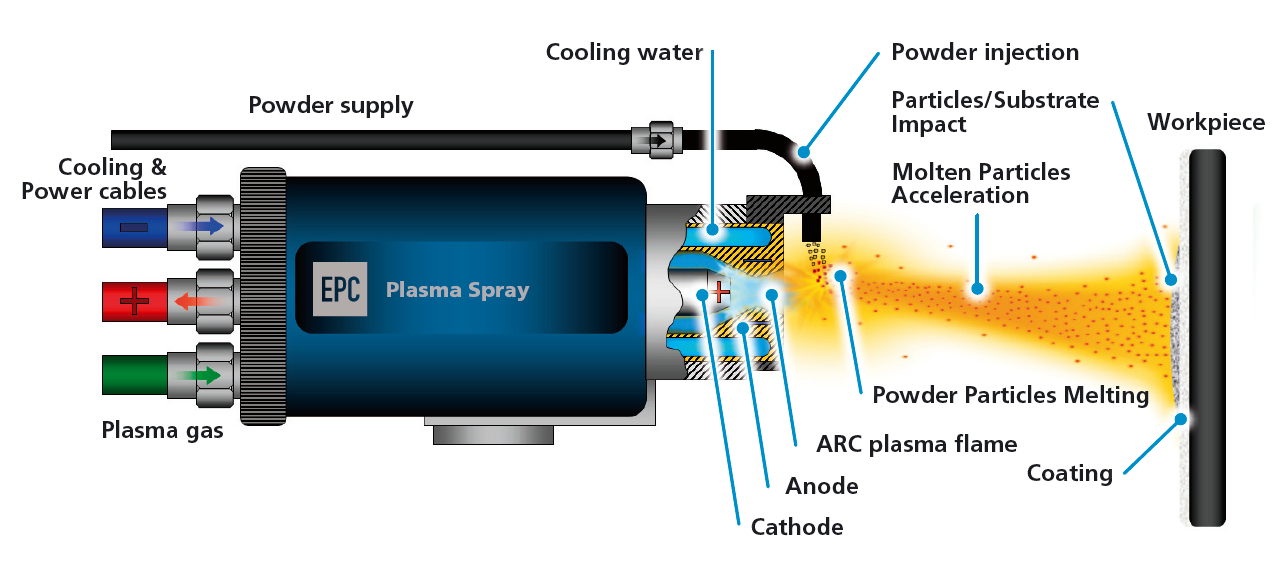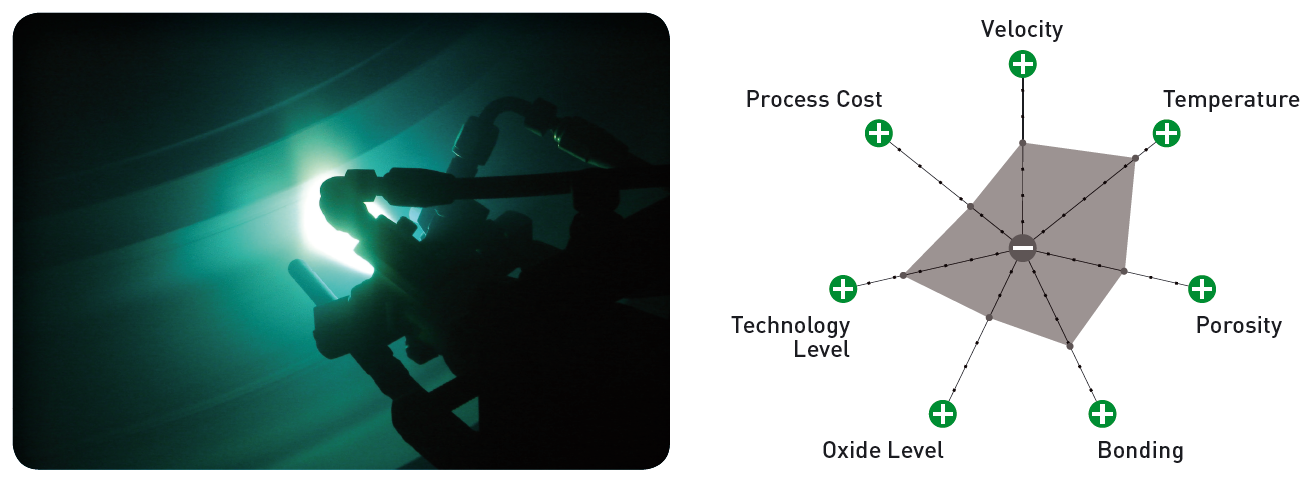The plasma spraying process utilises a highly energetic plasma jet to melt and accelerate material particles allowing the sprayed deposition of the coating.
In this process the heat source (plasma) is formed by the generation of a high density arc current in the space between cathode and anode filled with molecular or mono-atomic gases such as H2 or Ar. Ionised gases heat up to the temperatures of about 15,000°C and expand outside the nozzle reaching supersonic velocities.
Properties of the plasma stream can be controlled by cathode-nozzle arrangement (geometry), gas type, gas mixture ratio and electric arc settings. The resulting plasma stream can therefore greatly influence the degree of melting and acceleration of the chosen material, allowing deposition of coatings with tailored microstructural properties for specific industrial applications.


Coatings applied with plasma spraying:
- Pure metals (Cu, Al, Zn, Ni, Mo, W,…)
- Alloys (NiCr, NiAl, NiMoAl, NiCrSiB, Tribaloy, Inconel, Stellite, …)
- Carbides (WC/Co, CrC/NiCr, …)
- Ceramics (Al2O3, TiO2, Cr2O3, ZrO2/Y2O3, …)
- Abradables (Ni/Graphite, AlSi/Polyester, …)
Vast variety of material combinations allow plasma spraying to be used in wide spectrum of industrial applications providing:
- wear resistance
- corrosion resistance
- oxidation resistance
- thermal and electrical insulation
- electrical conductivity
View EP Coatings list of accreditation’s, and contact us to discuss how our Plasma Spraying services can help solve your challenges faced by your business.
Frequently asked questions
What industries benefit most from plasma spray coatings services?
Plasma spray coatings services are widely used across industries such as energy, aerospace, oil & gas, and manufacturing. For example, energy and gas turbine components like combustor cans, blades, and abradable seals routinely use plasma-sprayed thermal barrier coatings (TBCs), combining a metallic bond coat (e.g., MCrAlY) with a ceramic top layer (e.g., yttria-stabilized zirconia) to withstand combustion temperatures above 950 °C.
What materials can be applied using plasma spray coatings process?
Plasma spraying enables the deposition of various materials, including pure metals (e.g., Cu, Al, Ni), alloys (NiCr, Inconel, tribaloy, Stellite), carbides (WC/Co, CrC/NiCr), ceramics (Al₂O₃, TiO₂, ZrO₂/Y₂O₃), and abradable coatings (Ni/Graphite, AlSi/Polyester).
How does the plasma spray process work in coatings services?
The plasma spray coatings services use an energetic plasma jet—generated by an arc between a cathode and anode with gases like hydrogen or argon reaching ~15,000 °C—to melt and accelerate feedstock particles. Adjustments to nozzle geometry, gas mixture, and power settings control the coating’s microstructure, enabling tailored performance characteristics.
What surface properties can plasma spray coatings enhance?
Plasma-sprayed coatings enhance key surface properties such as wear resistance, corrosion resistance, oxidation resistance, thermal insulation, and electrical insulation or conductivity—all achievable through carefully selected materials and process control.
Where can I find a plasma coating provider in the UK and US?
Specialist plasma coating providers such as EP Coatings deliver advanced plasma spray services for industries including aerospace, oil & gas, and energy. Based in the UK and US and supported by the global STS Group, they ensure the same high-quality plasma coating technologies are also available to customers in the US. This makes EP Coatings a trusted partner for companies needing reliable plasma spray coating solutions on both sides of the Atlantic.